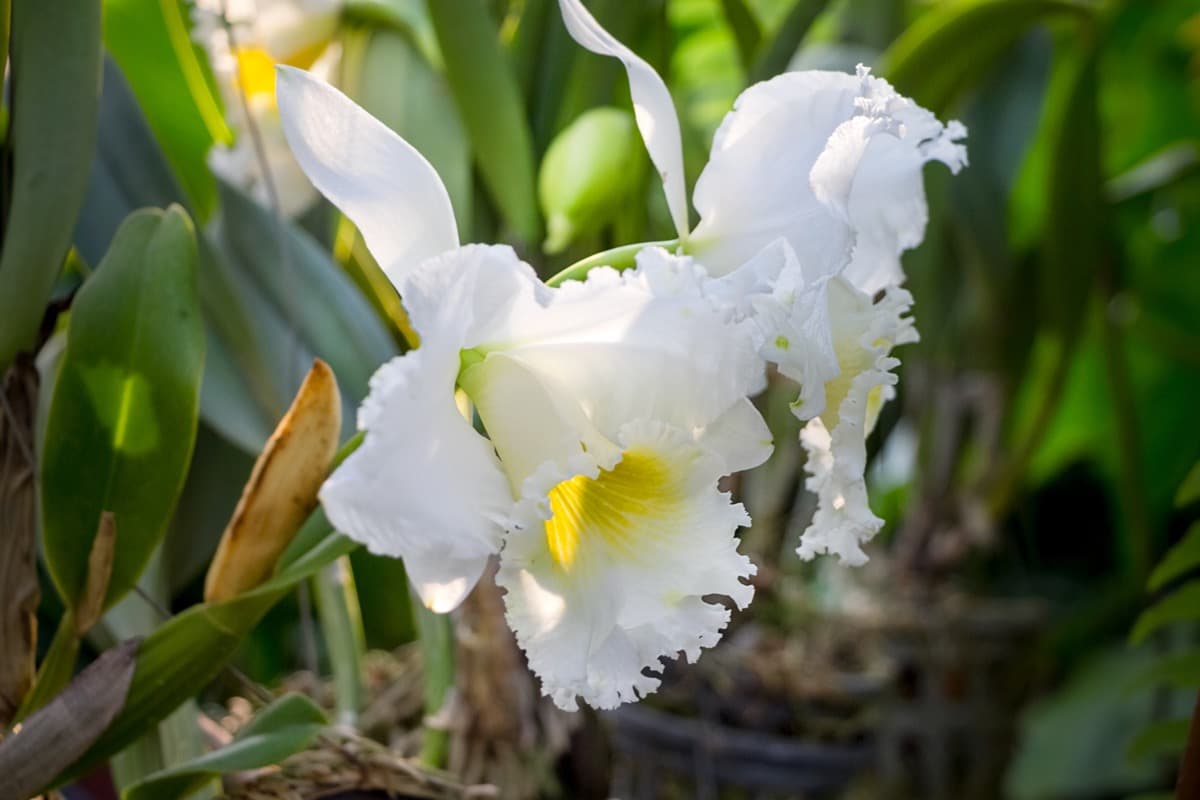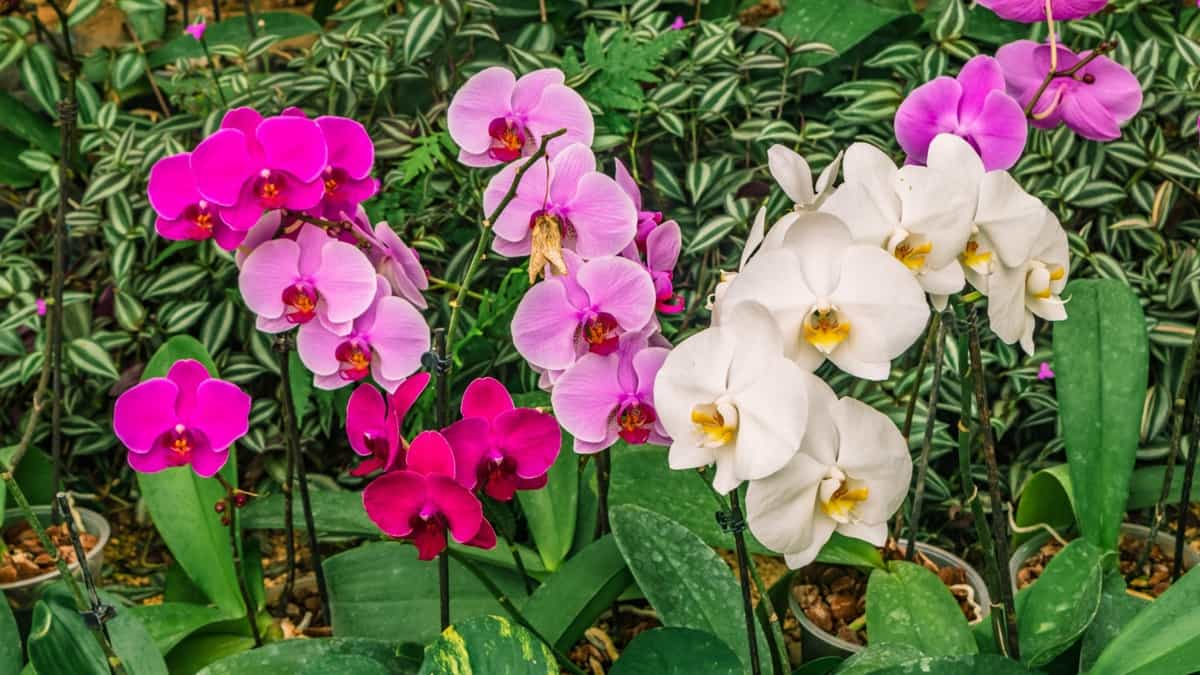Yellowing orchid leaves isn’t uncommon, but it may indicate your plant needs some help. At some point, the oldest leaves will turn yellow and fall off naturally, but it’s important to watch for younger or newer leaves turning yellow as a sign of trouble. Some causes of leaf yellowing can threaten the plant’s life, but they’re all reversible if caught in time. In this article, “ultimate guide to treating yellow leaves on your orchids,” we will share 8 of the most common reasons your orchid leaves turn yellow and tips for treating yellow leaves on your orchids.

Treating Yellow Leaves on Your Orchids
Improper watering and Yellowing Leaves in Orchids
Overwatering is the most common cause of yellowing orchid leaves. This can indicate that they are being watered too frequently. Also, they may be in a container that does not allow adequate drainage. Putting them in containers reduces the flow of air around their roots. A too-frequent watering prevents the potting medium from drying out, and the roots become soft and mushy. As a result, your orchids will become susceptible to root rot. If the potting medium is dry up to the top inch, then it is time to water the plant.
Make sure the pot has enough holes for proper drainage. Trim the rotted roots on your orchid, and repot the plant in a new orchid potting mix if your plant suffers from root rot. Instead of watering the leaves the first week, mist them. Underwatering is another cause of yellow leaves in orchids. When an orchid is not watered enough, it can become dehydrated, and the leaves will turn yellow. Orchids should be watered regularly, but not too frequently. It’s important to find the right balance between underwatering and overwatering.
Nutrient Deficiencies Leading to Yellow Leaves in Orchids
During the summer, moth orchids need fertilizer every third to fourth week as diluted orchid fertilizer. Unless orchids receive enough nitrogen and magnesium, they cannot produce chlorophyll, resulting in yellow leaves. If the tips and sides of the orchid’s leaves begin to yellow, your plant may be deficient in nitrogen or magnesium.
The most common orchid deficiencies are manganese, zinc, iron, and nitrogen. These are all essential for proper growth and require fertilizer. In the summer, fertilizer should be applied regularly, but fertilizer should be stopped in the fall, winter, and spring.
Sunburn and Yellowing of Orchid Leaves
Sunburn and yellowing of orchid leaves are common problems that orchid growers face. Sunburn occurs when the orchid is exposed to direct sunlight for an extended period. This can cause the leaves to turn brown, black, or yellow. If the sunburn is severe, the leaves may become dry and brittle.
To treat yellow leaves on your orchids caused by sunburn, it is important to provide your orchids with the proper amount of shade. This can be achieved by placing the orchids in an area with indirect sunlight or using shade cloth. It is also important to avoid exposing your orchids to direct sunlight during the hottest part of the day.
Pest Infestation Causing Yellow Leaves on Orchids
- Aphids are soft-bodied small insects that feed on the sap of orchid leaves and stems. They can cause leaf yellowing, curling, and stunted growth.
- Mealybugs are small, white insects that resemble cotton. They also suck the sap from the leaves, causing them to turn yellow and wilt.
- Spider mites are tiny arachnids that spin fine webs on orchid leaves and suck out their sap. They cause yellow spots, stippling, and eventually leaf drop.
- Thrips are slender insects that feed on orchid leaves, causing them to turn yellow, curl, and become distorted.
In case you missed it: 9 Reasons Why Your Orchid Flowers Are Falling Off: Treatment and Solutions

Pest Control
| Pest | Control methods |
| Aphids | Insecticidal soap or oils such as neem or canola oil |
| Mealybugs | Isopropyl (rubbing) alcohol or homemade dish soap spray |
| Spider mites | Vegetable oil or rubbing alcohol, or a mixture of dish soap and water |
| Thrips | Insecticidal soap or Malathion or Acephate |
Temperature Stress and Yellow Leaves in Orchids
Unlike most tropical house plants and flowers, orchids are more sensitive to air temperature. Yellowing leaves can be caused by even a few hours of too-high or too-low temperatures. Orchids grown indoors should always stay above 15°C unless grown outdoors or have general hardiness.
Yellowing and other signs of stress can be caused by short dips below this level. To treat yellow leaves on your orchids caused by temperature stress, most orchid species should avoid temperatures above 24-26°C, especially in enclosed areas where humidity may spike or fall. In particular, orchids that grow well at cooler temperatures, like Odontoglossums, Cymbidiums, and Dendrobiums.
Fungal Infections and Yellowing of Orchid Leaves
A fungal infection can cause yellowing leaves on the bottom of the leaves. Yellowing leaves with a foul odor may indicate a bacterial or fungal infection. It is often caused by over-watering and may eventually result in crown, root, or stem rot. The orchid leaves will eventually turn black, affecting both sides. To combat these infections, fungicides can be used. One effective fungicide is chlorothalonil, which prevents fungal spores from germinating. Another option is propiconazole, which interferes with fungal cell membranes and ultimately leads to cell death.
Root Problems and Yellowing Leaves in Orchids
Root problems can occur for various reasons, including overwatering, poor drainage, and fungal or bacterial infections. Signs of root problems include wilted leaves, yellow or brown roots, and a foul odor. To address root problems, it is important to carefully inspect the roots and remove those that are soft, mushy, or discolored. Repotting the orchid in fresh, well-draining soil can also help prevent future root problems.
Transplant Shock and Yellow Leaves on Orchids
- If your orchid has recently undergone a transplant and you notice yellowing leaves, your plant is likely experiencing transplant shock. The good news is that transplant shock is a temporary condition that can be remedied properly.
- To help your orchid recover from transplant shock, giving it the right amount of water and sunlight is important. Orchids need to be watered regularly, but overwatering can harm their roots. Make sure to water your orchid only when the soil is dry to the touch.
- In addition to proper watering, your orchid also needs adequate sunlight. Orchids thrive in bright, indirect light, so be sure to place your plant where it can receive the right amount of light.
In case you missed it: How to Grow and Care for Orchid Plants Indoors: A Step-By-Step Comprehensive Guide

Conclusion
Yellow leaves on orchids can be a cause for concern, but with the right knowledge and treatment methods, you can restore your plant’s health and vibrancy. By understanding the causes of yellowing leaves and implementing appropriate treatments, you can enjoy the beauty of your orchids for years to come.
- Feed Your Flock for Less: Top 10 Tips to Save on Chicken Feed
- Ultimate Guide to Ossabaw Island Hog: Breeding, Raising, Diet, and Care
- Hatching Answers: The Top 10 Reasons Your Chickens Aren’t Laying Eggs
- Eggs and Economics: Breaking Down the Cost of Raising Backyard Chickens
- Defend Your Greens: Proven Methods to Keep Iguanas Out of Your Garden
- Ultimate Guide to Cinnamon Queen Chicken: A Comprehensive Guide for Beginners
- Ultimate Guide to California Tan Chicken: Breeding, Raising, Diet, Egg-Production and Care
- Ultimate Guide to Marsh Daisy Chicken: Breeding, Raising, Diet, and Care
- 10 Types of Chicken Farming Businesses You Can Start for Profits